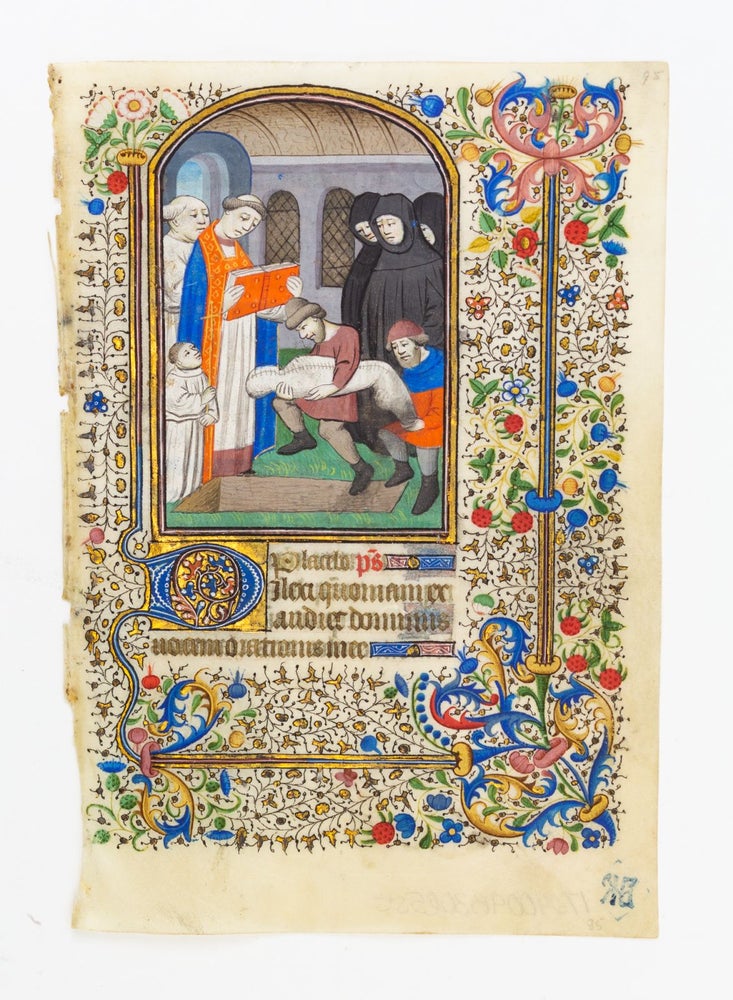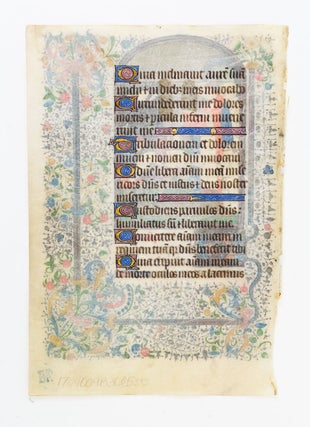TEXT FROM THE OFFICE OF THE DEAD.
(France (probably Paris): ca. 1440). 181 x 125 mm. (7 1/8 x 5"). Single column, verso with 16 lines in a gothic book hand.
Rubrics in red, line enders in blue and pink with white tracery and central gilt bezant, seven one-line initials in gold on pink and blue ground with white tracery, one three-line initial in blue with white tracery, filled with red and blue ivy leaves and on gold ground, WITH A HALF-PAGE MINIATURE DEPICTING A BURIAL SCENE in a thin arch-topped gold frame, WITH A FULL BORDER of hairline vines, gilt bezants and ivy leaves, colorful acanthus, and flowers, densely arranged around gold and painted bars. Lower fore-edge corner of recto with a small blue ink stamp of the library of Count Nicholai Alexanderovich Kushelev-Bezborodko. ◆Inner margin a little small near bottom (but without loss), slight smudge at the foot of the burial shroud, but IN VERY FINE CONDITION, the color and detail beautifully preserved.
Apart from those relatively few copies with illustrated calendars, the miniatures found in Books of Hours are almost entirely devoted to retrospective Bible scenes that are obviously outside the experience of the illuminator; it is only in the present kind of scene at the beginning of the Office of the Dead that we can see a contemporaneous image that would have come directly from the Medieval experience. The present scene represents the final stage of the funerary event, in which the body is actually laid to rest in the ground (this being preceded by the funeral procession, Requiem Mass, prayers, Absolution, and the procession into the graveyard). Though the corpse would have been encased in a coffin during the aforementioned rites and processions, it was customary to bury the dead in only a shroud (in the present example, the artist has even thought to show the stitching along the length of the shroud). Three groups of people, each serving a different function, appear in this miniature: in the foreground are two laborers lowering the body into an earthen grave, a small group of mourners in black cloaks stand behind them at the right, and a duo of clergy members stand to the left, with a young boy, holding a processional cross at their side. One of the clergymen, presumably the priest, wears a blue cope (donned prior to administering Absolution to the deceased) and holds a manuscript codex containing the Rites for Burial. Though the faces have all been painted without much modelling, the artist manages to express a surprising amount of emotion on each visage: the mourners and clergy appear sorrowful with downcast eyes, the laymen are solemn yet pragmatic as they attend to their task, and the small boy, the only one looking upward, observes the scene with quiet curiosity. It is interesting to note that the somber character of the miniature is at odds with the riot of colorful and beautifully rendered decoration in the borders, reminding us that the manuscript from which this painting came was a luxury object. Apparently the parent manuscript was owned in the 18th century by "Mr Jourdan Secrétaire de Mgnr l'ancien Evêque de Limoges Precepteur des Enfans de Françe"; by the 19th century it was part of the library of Count Nicholai Alexandrovich Kushelev-Bezborodko (1834-62), a Russian senator and art collector who built a world-class collection of art and sculpture. After his untimely death, much of his collection went to the Imperial Academy of Art's newly formed Kushelevskaya Gallery (and later became part of the Hermitage and Pushkin museums). It appears that the manuscript was sold at Christie's on 7 December 1988, lot 22 (imperfect, with only three miniatures), and again at Sotheby's on 5 December 2000, lot 61, and was broken up sometime thereafter. (ST17240)
Price: $7,500.00


